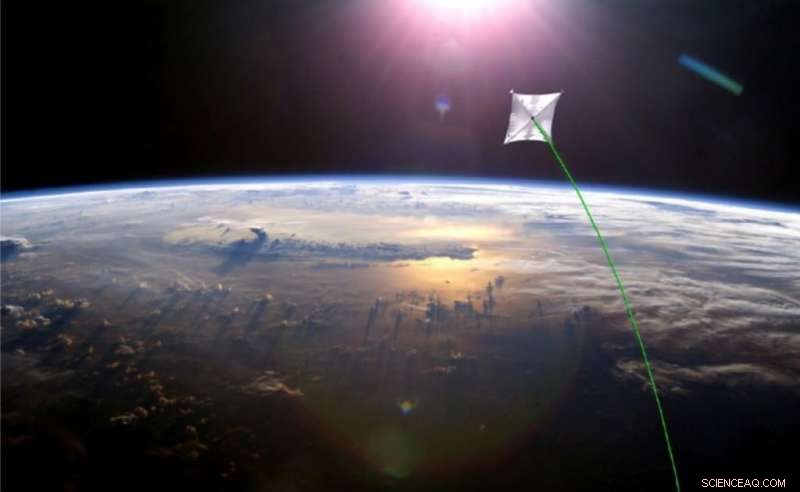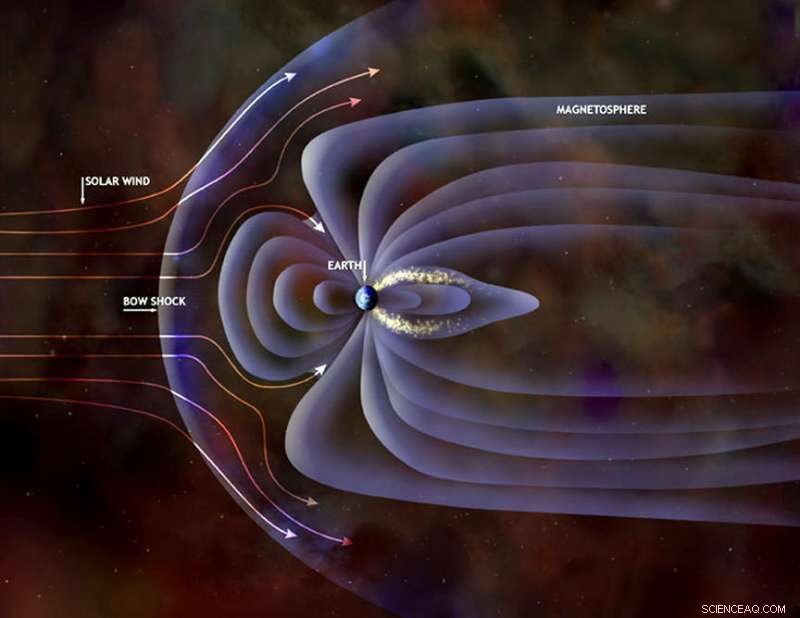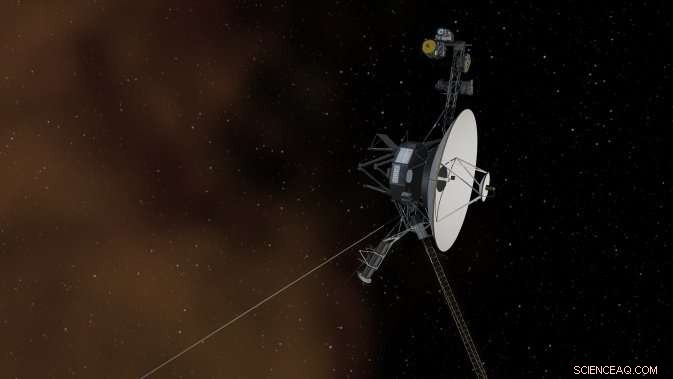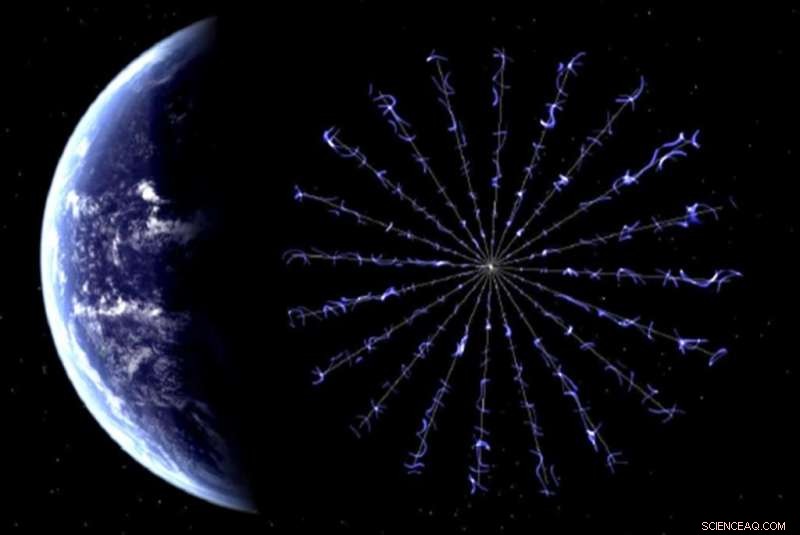
Conceito artístico de uma missão de demonstração de vela solar que utilizará lasers para navegação. Crédito:NASA
Estamos todos familiarizados com a ideia de velas solares para explorar o sistema solar, usando a leve pressão do sol. Mas há outro sistema de propulsão que poderia aproveitar a energia do sol, velas elétricas, e é uma ideia muito interessante.
Algumas semanas atrás, Eu respondi a uma pergunta que alguém tinha sobre meus sistemas de propulsão exóticos favoritos, e eu revelei algumas ideias que acho empolgantes:velas solares, foguetes nucleares, motores iônicos, etc. Mas há outro sistema de propulsão que continua surgindo, e eu esqueci totalmente de mencionar, mas é uma das melhores ideias que ouvi há algum tempo:velas elétricas.
Como você deve saber, uma vela solar funciona aproveitando os fótons da luz que emanam do sol. Embora os fótons não tenham massa, eles têm impulso, e pode transferi-lo quando eles ricocheteiam em uma superfície reflexiva.
Além da luz, o sol também está soprando um fluxo constante de partículas carregadas - o vento solar. Uma equipe de engenheiros da Finlândia, liderado pelo Dr. Pekka Janhunen, propôs a construção de uma vela elétrica que usará essas partículas para transportar a espaçonave para o sistema solar.
Para entender como isso funciona, Precisarei inserir alguns conceitos em seu cérebro.
Primeiro, o sol. Essa bola mortal de radiação no céu. Como você deve saber, há um fluxo constante de partículas carregadas, principalmente elétrons e prótons, fugindo do sol em todas as direções.
Os astrônomos não têm certeza de como, mas algum mecanismo na coroa do sol, sua atmosfera superior, acelera essas partículas em uma velocidade de escape. Sua velocidade varia de 250 a 750 km / s.
O vento solar viaja para longe do sol, e para o espaço. Vemos seus efeitos nos cometas, dando-lhes suas caudas características, e forma uma bolha ao redor do sistema solar conhecida como heliosfera. É aqui que o vento solar do sol encontra os ventos solares coletivos de outras estrelas da Via Láctea.
Na verdade, A espaçonave Voyager da NASA recentemente passou por esta região, finalmente abrindo caminho para o espaço interestelar.
O vento solar causa uma pressão direta, como um vento de verdade, mas é incrivelmente fraco, uma fração da pressão leve que uma vela solar experimenta.
Mas o vento solar tem carga negativa, e esta é a chave.
Uma vela elétrica funciona desenrolando um fio incrivelmente fino, apenas 25 mícrons de espessura, mas 20 quilômetros de comprimento. A espaçonave está equipada com painéis solares e um canhão de elétrons que leva apenas algumas centenas de watts para funcionar.

Visualização do vento solar encontrando as "defesas" magnéticas da Terra conhecidas como magnetosfera. Nuvens de plasma apontando para o sul são capazes de descascar camadas da bolha voltada para o Sol e empilhá-las em camadas no lado noturno do planeta (centro, direito). As camadas podem ser comprimidas com força suficiente para reconectar e enviar elétrons solares (faíscas amarelas) diretamente para a atmosfera superior para criar a aurora. Crédito:JPL
Ao disparar elétrons para o espaço, a espaçonave mantém um estado de carga altamente positiva. À medida que as partículas carregadas negativamente do sol encontram a amarra carregada positivamente, eles o "veem" como um grande obstáculo de 100 metros de largura, e colidir com ele.
Ao transmitir seu impulso à corda e à espaçonave, os íons o aceleram para longe do sol.
A quantidade de aceleração é muito fraca, mas é uma pressão constante do sol e pode aumentar ao longo de um longo período de tempo. Por exemplo, se uma espaçonave de 1000 kg tivesse 100 desses fios se estendendo em todas as direções, ele poderia receber uma aceleração de 1 mm por segundo por segundo.
No primeiro segundo, ele viaja 1 mm, e então 2 mm no próximo segundo, etc. Ao longo de um ano, esta espaçonave poderia estar indo a 30 km / s. Apenas para comparação, a espaçonave mais rápida que existe, Voyager 1 da NASA, está apenas a cerca de 17 km / s. Então, muito mais rapido, definitivamente em uma velocidade de escape do sistema solar.
Uma das desvantagens do método, na realidade, é que não funcionará na magnetosfera da Terra. Portanto, uma espaçonave movida a vela elétrica precisaria ser carregada por um foguete tradicional para longe da Terra antes que pudesse desenrolar sua vela e seguir para o espaço profundo.
Tenho certeza que você está se perguntando se esta é uma viagem só de ida para fugir do sol, mas na verdade não é. Assim como velas solares, uma vela elétrica pode ser girada. Dependendo de qual lado da vela o vento solar atinge, it either raises or lowers the spacecraft's orbit from the sun.

This artist’s concept shows the Voyager 1 spacecraft entering the space between stars. Interstellar space is dominated by plasma, ionized gas (illustrated here as brownish haze), that was thrown off by giant stars millions of years ago. Crédito:NASA
Strike the sail on one side and you raise its orbit to travel to the outer solar system. But you could also strike the other side and lower its orbit, allowing it to journey down into the inner solar system. It's an incredibly versatile propulsion system, and the sun does all the work.
Although this sounds like science fiction, there are actually some tests in the works. An Estonian prototype satellite was launched back in 2013, but its motor failed to reel out the tether. The Finnish Aalto-1 satellite was launched in June 2017, and one of its experiments is to test out an electric sail.
We should find out if the technique is viable later this year.
It's not just the Finns who are considering this propulsion system. Em 2015, NASA announced that they had awarded a Phase II Innovative Advanced Concepts grant to Dr. Pekka Janhunen and his team to explore how this technology could be used to reach the outer solar system in less time than other methods.
The Heliopause Electrostatic Rapid Transit System, or HERTS spacecraft would extend 20 of these electric tethers outward from the center, forming a huge circular electric sail to catch the solar wind. By slowly rotating the spacecraft, the centrifugal forces will stretch the tethers out into this circular shape.
With its positive charge, each tether acts like a huge barrier to the solar wind, giving the spacecraft an effective surface area of 600 square kilometers once it launches from the Earth. As it gets farther, from Earth, no entanto, its effective area increases to the equivalent of 1, 200 square km by the time it reaches Jupiter.

Artist’s illustration of NASA’s Heliopause Electrostatic Rapid Transit System. Crédito:NASA
When a solar sail starts to lose power, an electric sail just keeps accelerating. Na verdade, it would keep accelerating out past the orbit of Uranus.
If the technology works out, the HERTS mission could reach the heliopause in just 10 years. It took Voyager 1 35 years to reach this distance, 121 astronomical units from the sun.
But what about steering? By changing the voltage on each wire as the spacecraft rotates, you could have the whole sail interact differently on one side or the other to the solar wind. You could steer the whole spacecraft like the sails on a boat.
Em setembro de 2017, a team of researchers with the Finnish Meteorological Institute announced a pretty radical idea for how they might be able to use electric sails to comprehensively explore the asteroid belt.
Instead of a single spacecraft, they proposed building a fleet of 50 separate 5-kg satellites. Each one would reel out its own 20 km-long tether and catch the sun's solar wind. Over the course of a 3-year mission, the spacecraft would travel out to the asteroid belt, and visit several different space rocks. The full fleet would probably be able to explore 300 separate objects.
Each spacecraft would be equipped with a small telescope with only a 40 mm aperture. That's about the size of a spotting scope, or half a pair of binoculars, but it would be enough to resolve features on the surface of an asteroid as small as 100 meters across. They'd also have an infrared spectrometer to be able to determine what minerals each asteroid is made of.

This image depicts the two areas where most of the asteroids in the solar system are found:the asteroid belt between Mars and Jupiter, and the trojans, two groups of asteroids moving ahead of and following Jupiter in its orbit around the sun.
That's a great way to find that $10 trillion asteroid made of solid platinum.
Because the spacecraft would be too small to communicate all the way back to Earth, they'd need to store the data on board, and then transmit everything once they came past our planet 3 years later.
The planetary scientists I've talked to love the idea of being able to survey this many different objects at the same time, and the electric sail idea is one of the most efficient methods to do it.
De acordo com os pesquisadores, they could do the mission for about $70 million, bringing the cost to analyze each asteroid down to about $240, 000. That would be cheap compared to any other method proposed of studying asteroids.
Space exploration uses traditional chemical rockets because they're known and reliable. Sure they have their shortcomings, but they've taken us across the solar system, to billions of kilometers away from Earth.
But there are other forms of propulsion in the works, like the electric sail. And over the coming decades, we're going to see more and more of these ideas put to the test. A fuel free propulsion system that can carry a spacecraft into the outer reaches of the solar system? Yes please.